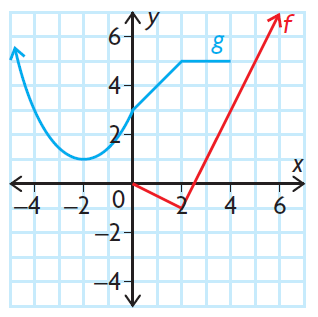FIND COMPOSITION OF TWO FUNCTIONS
Subscribe to our ▶️ YouTube channel 🔴 for the latest videos, updates, and tips.
The composition of a function g with a function f is :
h(x) = g(f (x))
The domain of h is the set of all x-values such that x is in the domain of f and f (x) is in the domain of g.
Problem 1 :
Given f(x) = -9x + 3 and g(x) = x4, find (f ∘ g)(x)
Solution :
(f ∘ g)(x) = f(g(x))
= f(x4)
= -9(x4) + 3
(f ∘ g)(x) = -9x4 + 3
Problem 2 :
Given f(x) = 2x – 5 and g(x) = x + 2, find (f ∘ g)(x)
Solution :
(f ∘ g)(x) = f(g(x))
= f(x + 2)
= 2(x + 2) – 5
= 2x + 4 – 5
= 2x - 1
(f ∘ g)(x) = 2x - 1
Problem 3 :
Given f(x) = x2 + 7 and g(x) = x - 3, find (f ∘ g)(x)
Solution :
(f ∘ g)(x) = f(g(x))
= f(x - 3)
= (x - 3)2 + 7
= x2 + (3)2 – 2(x)(3) + 7
= x2 + 9 - 6x + 7
(f ∘ g)(x) = x2 - 6x + 16
Problem 4 :
Given f(x) = 4x + 3 and g(x) = x2, find (g ∘ f)(x)
Solution :
(g ∘ f)(x) = g(f(x))
= g(4x + 3)
= (4x + 3)2
= (4x)2 + (3)2 + 2(4x)(3)
= 16x2 + 9 + 24x
(g ∘ f)(x) = 16x2 + 24x + 9
Problem 5 :
Given f(x) = x – 1 and g(x) = x2 + 2x - 8, find (g ∘ f)(x)
Solution :
(g ∘ f)(x) = g(f(x))
= g(x - 1)
= (x – 1)2 + 2(x – 1) - 8
= (x)2 + (1)2 – 2(x)(1) + 2x – 2 - 8
= x2 + 1 - 2x + 2x - 10
(g ∘ f)(x) = x2 - 9
Problem 6 :
Use f(x) = 2x + 3 adn g(x) = 1 - x2 to evaluate the following expressions.
a) f (g(0)) b) g (f(4)) c) (f ∘ g) (-8)
d) (g ∘ g) (1/2) e) (f ∘ f-1) (1) f) (g ∘ g) (2)
Solution :
f(x) = 2x + 3 adn g(x) = 1 - x2
a) f (g(0))
g(0) = 1 - 02
= 1
Applying the value of g(0), we get
f (g(0)) = f (1)
= 2(1) + 3
= 2 + 3
= 5
b) g (f(4))
f(4) = 2(4) + 3
= 8 + 3
= 11
Applying the value of f(4), we get
g (f(4)) = g(11)
= 1 - 112
= 1 - 121
= -120
c) (f ∘ g) (-8) = f [g(8)]
g(8) = 1 - 82
= 1 - 64
= -63
Applying the value of g(8), we get
= f(-63)
= 2(-63) + 3
= -126 + 3
= -123
d) (g ∘ g) (1/2) = g[g(1/2)]
g(1/2) = 1 - (1/2)2
= 1 - (1/4)
g(1/2) = 3/4
Applying the value of g(1/2), we get
g(3/4) = 1 - (3/4)2
= 1 - 9/16
= (16-9)/16
= 7/16
e) (f ∘ f-1) (1) = f[f-1) (1)]
Evaluating f-1 (x) :
Let y = 2x + 3
y - 3 = 2x
x = (1/2) (y - 3)
Replace x by f-1 (x) and y by x.
f-1 (x) = (1/2) (x - 3)
f-1 (1) = (1/2) (1 - 3)
= -2/2
= -1
By applying the value of f-1 (1) = -1, we get
f[f-1) (1)] = f(-1)
= (1/2)(-1-3)
= -4/2
= -2
f) (g ∘ g) (2) = g[g(2)]
g(2) = 1 - 22
= 1 - 4
= -3
Applying the value of g(2), we get
= g(-3)
g(-3) = 1 - (-3)2
= 1 - 9
= -8
Problem 7 :
Given f = {(0, 1) (1, 2) (2, 5) (3, 10)} and g = {(2, 0)(3, 1)(4, 2)(5, 3)(6, 4)} determine the follwoing
|
a) (g ∘ f) (2) b) (f ∘ f) (1) c) (f ∘ g) (5) |
d) (f ∘ g) (0) e) (f ∘ f-1) (2) f) (g-1 ∘ f) (1) |
a) (g ∘ f) (2) = g[f(2)]
When input is 2, the output will be 5.
= g(5)
When the input is 5, the output will be 3.
b) (f ∘ f) (1) = f[f(1)]
When the input is 1, the output is 2.
= f(2)
= 0
c) (f ∘ g) (5) = f[g(5)]
= f[3]
= 10
d) (f ∘ g) (0) = f(g(0))
There is no input 0 for the function g. So, it is undefined.
e) (f ∘ f-1) (2) = f[f-1(2)]
f-1(2) = 1
= f(1)
= 2
f) (g-1 ∘ f) (1) = g-1 (f(1))
= g-1 (2)
= 4
Problem 8 :
Use the graphs of f and g to evaluate each expression.
a) f(g(2))
b) (g ∘ g) (-2)
c) (g ∘ f) (4)
d) (f ∘ f) (2)

a) f(g(2)) = f(5)
= 5
b) (g ∘ g) (-2) = g(g(-2))
= g(1)
= 4
c) (g ∘ f) (4) = g(f(4))
= g(3)
= 5
d) (f ∘ f) (2) = f(f(2))
= f(-1)
= undefined.
Subscribe to our ▶️ YouTube channel 🔴 for the latest videos, updates, and tips.
Recent Articles
-
Finding Range of Values Inequality Problems
May 21, 24 08:51 PM
Finding Range of Values Inequality Problems -
Solving Two Step Inequality Word Problems
May 21, 24 08:51 AM
Solving Two Step Inequality Word Problems -
Exponential Function Context and Data Modeling
May 20, 24 10:45 PM
Exponential Function Context and Data Modeling